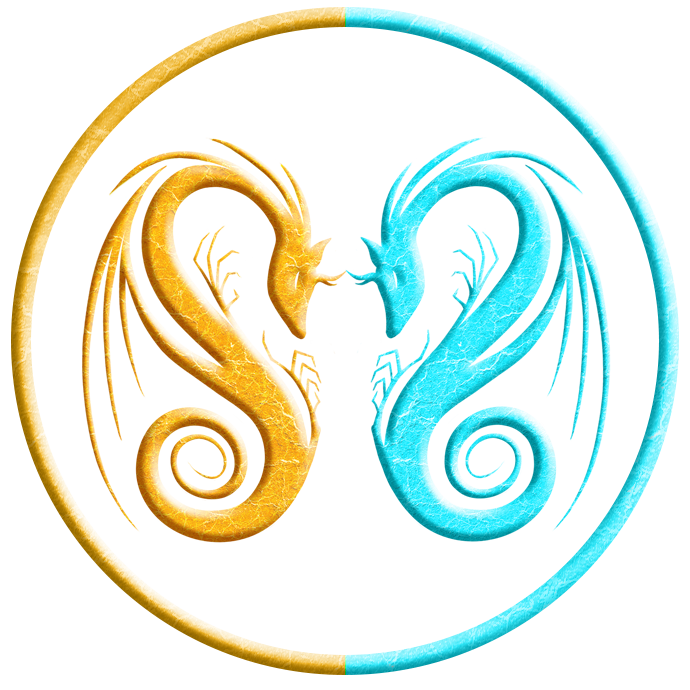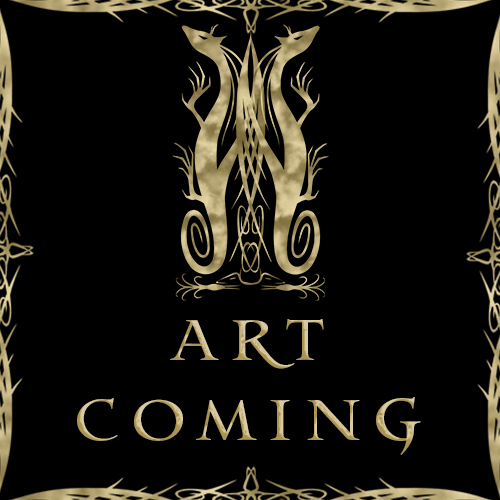Dragons: Myth
Dragons hold a place of esteem within human mythology. Not only did the Earth Mother create them herself, they helped sylfaodolon mold Elthessera into a habitable sphere.
Dragons remained central to human legend for thousands of years, but while fairy tales and bard stories still star the large beasts, placing them as the center of actual historic events, like the creation of the Jonna Empire, has fallen out of favor.
Still, something about the large, magickal beasts continues to draw interest. Royalty and warlords link their ancestors to them, mystery artists and scholars claim they have blessed their academies, and the religious see them as sylfaodolon. Commoners enjoy the thought of dragon justice punishing corrupt nobles.
Most southern Seari scholars agree, while dragons have been used for millennia as an excuse for the downfall and creation of countless civilizations and countries, they never existed. Northern Seari scholars remain mute on the topic.
In this document:
All artwork by Shanda Nelson unless otherwise stated
The Five Dragon Families
Deities destroyed the first world the Five Creators formed, and the Earth Mother pondered how to guide overwhelming power into a less destructive leaning while they created a second sphere. Thus she begat the dragons, beings who came solely from her hand rather than as a communal project between the other four Creators. Numerous myths surround these events, with an emphasis on dragons being lights amid chaos, and as bound to the new sphere as the new sylfaodolon were bound to their natures. As such, they became the sphere's guardians, ever keeping a watchful eye on deities. Different ways of offering advice and holding deities in check flourished, tangentially related to the ways each of the Five Creators viewed the new sphere and its inhabitants. Dragons migrated to those of a like mind, whome they called siblings. When they mated and had children, they became family. Thus the Five Dragon Families of Creation formed. Dragons in these ancient tales understand the world far better than the sylfaodolon who sought to enhance the Creators' foundation, and their guidance and advice became invaluable. Several morality tales take place during this time, with sylfaodolon foolishly ignoring dragon suggestions, and suffering the ill consequences. Religious orders enjoy these stories; the non-religious, not so much.
Ancient dragons did not just keep an eye on sylfaodolon. When humans committed an act so egregious dragons felt honor-bound to punish those involved, they exacted dragon justice. Their might, both physical and magickal, made certain their targets did not live to regret their actions.
Many a human generation lived in terror of dragon justice.
In myth, the five dragon families are mortal enemies of the sfincks. Most modern Seari scholars believe this is a reflection of the conflicts that occured between Seari and Yena thousands of years ago. These conflicts ebbed and flowed until the volcanic eruption that drove the Ga Iniria across the Strait of Co Jer. At that point, the sfincks dropped from the myths of both continents.
The Five Dragons
In peoples south of the Sea of Condioh, the legends of the Five Dragon Families gave way to the Five Dragons. The change occurred alongside the formation of the Gada Kiore myths, which, according to scholars, began some twenty thousand years ago. These five dragons changed from guardians of the Earth Mother's sphere to helpers of human masters in civilization-changing adventures. Why dragons went from helpers of creation to followers of human whims has much expose and no difinitive answer, though most agree it has something to do with humans taming something else. That something else ranges from environments to other peoples, monsters, and even sylfaodolon. This, scholars explain, is why the legends began to focus on special artifacts called the dragonstones. Dragonstones magickally linked human champions (never sylfaodolon or other beings) to the dragons. If a champion wanted to become a master, they needed to find the stone. So they would enter a lair and traverse many dangerous areas to reach the artifact. Once they discovered its hiding place, a trial took place, and if the champion survived, they became a master and the stone formed a bond with the dragon. These stories became very popular with commoners, because one's birth did not dictate the outcome of a successful attempt. Dragons would bond with whoever conquered the dragonstone trials, they did not care if they were rich, poor, a swordsman or wielder, a farmer or a noble. While always popular, the Five Dragons took on added importance after the Condi kings claimed that the formation of the Jonna Empire was due to Kykini Cede, Flame Dragon of Kassak, and Lajaka, Ice Dragon of Lassa. Linking their conquering to dragons and reminding people of dragon justice put a moral stamp of approval on their subjugation that otherwise would not have existed.Modern Seari has seen a renewal in interest in the Five Dragons mythology, inspired by the not-subtle back and forth between northern and southern scholars in relation to historical, dragon-related events. Their arguments are especially sharp concerning Kykini Cede and Lajaka's presence during the creation of the Jonna Empire. Southern Seari scholars claim that King Giarel used their myth to drive fear into the hearts of the peoples he wanted to conquer, so that, in many cases, his fighting forces did not have to raise a sword before declaring victory. Northern Seari, especially the religious who inhabit First Light Island, believe dragons exist, and it is human folly as witnessed in the Jonna Empire that drove them away from mortal interactions.
Dragonpriests
While most people consider dragons mythological in nature, dragonpriests existed, and worshipped the Five Dragons until their order's demise 1900 years ago. Scholars have not pinpointed an exact date of inception from their writings, but they were around before the Ga Iniria sailed from Yena to Seari, over 5000 years ago. Dragonpriests claimed themselves stewards of dragon lairs, though most historians think of them more as priests who saw dragons as sylfaodolon, and curated their myths accordingly. Per their writings, they did not interfere in dragon trials, but they did manage the lairs like religious orders managed their sylfaone's platform, gave tours and offered advice supposedly given by the dragons themselves. They created magnificent works of art, music and magick for their chosen dragon. They suffered pilgrims (likely for money, because upkeep of a huge lair is expenseive), and built the Dikalari, the Dragon Road, to make pilgrimages easier. The Dikalari is their lasting legacy; it still exists, and is used as a major trade route that follows the eastern seaboard and southern coast before heading inland and around the Sea of Condi, to end in Rikondi, at the supposed entrance of the Well. Many major cities lie on this road, and civilizations have risen and fallen due to their access to it. Unfortunately, other religious orders held an Intense and bitter hatred for dragonpriests, and they obliterated their perceived enemy. By 3220 AGI, the order was no more. While their demise triggered a fall in popularity of the Five Dratgons' mythology, the tales. especially those concerning dragon justice, are still well-known in modern Seari.Gada Kiore
Gada Kiore is a constant character in dragon myth. While her tale dates to later than the Five Dragon Families, she is considered the Earth Mother's avatar, who humans revere and sylfaodolon jealously plot against. It makes her an essential element, whether the story involves dragons, deities, or both. She is the embodiment of earth, and therefore adds different elements to a story. She is the loving and patient teacher who carefully grows her students and companions and offers sage advise. She is also the destroyer, riding a volcanic anger that obliterates all in her path. Her reverence reached an all-time high during the two Sfincks Wars. In both, she valiantly protected Searans from the deadly ambitions of the invading Yenan and their sfincks, who never cared for much beyond their lust for land and power. Religious orders have no uniformity in how they treat her. She is the avatar of the Earth Mother, and is revered as a deity herself. She is known to resurrect deadlands, bringing new life and new green to the devastated areas. She nurtures and cradles living things. But she is also the bringer of destruction, the beast upon which the Mother rides when she wishes to rend sylfaodolon, and Arberiss, apart to punish deities for their transgressions. In this, she is the harbringer of ruination, for the populations that follow punished sylfaodolon rarely remain intact after such a traumatic event. The religious, as their sylfaone, must reset and rethink. Few have enjoyed the experience.The Dragons
Gada Kiore
- Meaning: Earth Mother
- Title: Earth Mother
- Lair: The Well (Rikondi)
- Wand: Gadari (Earth Stone)
- Temple: The Depths
Kykini Cede
- Meaning: Golden Shell
- Alternate Name: Coibe (Jonnese)
- Title: Flame Dragon of Kassak
- Lair: The Glass Volcano (Oritan)
- Wand: Kandari (Flame Stone)
- Temple: Black-shine Temple
Lajaka
- Meaning: Winter
- Alternate Name: Shtay (Jonnese)
- Title: Ice Dragon of Lassa
- Lair: Hekara's Abyss (Rakan)
- Wand: Vendari (Ice Stone)
- Temple: Lajaka edi kan’dero
Suva
- Meaning: Lake
- Alternate Name: Indra (Jonnese)
- Title: Water Dragon of Andrinne
- Lair: Crystal Waterfall (Verad)
- Wand: Shendari (Water Stone)
- Temple: Crystal Temple
Sykava
- Meaning: East Wind
- Alternate Names: Chechadra (Jonnese), Zarayna (Nae)
- Title: Wind Dragon of Vaur
- Lair: Seaside (Vaur)
- Wand: Jikedari (Wind Stone)
- Temple:





Comments